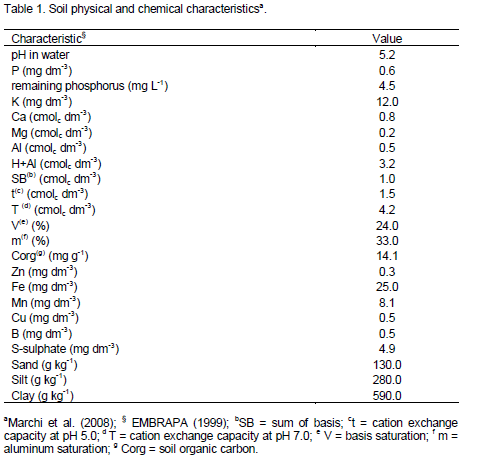ABSTRACT
The aim of this work was to test fertilizers, liming, and levels of a soil conditioner produced from leonardite, composed by humic and fulvic acids on “iceberg” lettuce growth characteristics. The experimental design was completely randomized in a 5×3×2 factorial scheme, with 5 levels of soil conditioner (0, 20, 40, 100 and 200 L ha-1), 3 fertilizers [chicken manure, plant compost (plant residues and cattle manure) and mineral], in limed and unlimed soil, with five replicates. The experiment was carried out in a greenhouse. Total shoot fresh and dry weight, shoot commercial fresh and dry weight, plants height, circumference, and number of leaves were evaluated as well as final soil pH and nutrient levels in leaves. Chicken manure rendered the greater circumference and shoot fresh commercial weight. Lettuce produced with chicken manure presented higher content of P, Ca, and Mg in leaves. Soil conditioner, in general, did not influence plant growth, except in its height, in the highest applied dose. With absence of lime, soil conditioner caused an increase of lettuce height with mineral fertilizers, and a decrease with plant compost.
Key words: Humic substances, Lactuca sativa L., chicken manure, compost.
Nowadays, studies on the use of organic materials are very important as the price of fertilizers is increasing. Benefits of organic fertilizers for soil quality and lettuce production were published before. Some publications reported effects of organic wastes (Costa et al., 1994), compost (Silva et al,2010), vermicompost (Ali et al.,2007), chicken manure (Peixoto Filho et al., 2013), and organo-minerals compounds (Luz et al., 2010) on lettuce growth characteristics. However, there is almost no information concerning effects of organic materials, liming and soil conditioners on lettuce growth characteristics and nutrition.
A source of organic materials that may improve soil quality and productivity are soil conditioners. Several kinds of soil conditioners, produced from organic sources, such as organic composts, humus, and coal, are being sold in the market. These soil conditioners, which are sold in solid or liquid form, are mainly constituted of humic and fulvic acids, and may contain plant nutrients. These humic compounds may be absorbed by roots and transported to shoots, thus enhancing the growth of the whole plant (Lulakis and Petsas, 1995; García et al., 2014). Effects of soil conditioners on plants were reported to improve the soil chemically, releasing cations, complexing nutrients and toxic aluminum (Stevenson, 1994).
One soil conditioner of interest is leonardite, which is a secondary mineral originated from “soft coals”, commonly associated to lignite which is obtained normally at near-surface mining. Leonardite contains high amounts (> 80%) of humic acids, thus it is used, commercially, as a main source of these acids. Humic acid is extracted from leonardite is by using alkaline solutions, such as potassium hydroxide. Very few works showed the effects of soil conditioners in plant growth characteristics (Valšíková and Viteková, 2006). In addition, the great majority of the studies on the effects of humic substances on plants were held in nutrient solutions, using inert substrates and generally under laboratory conditions, and not on soils or field conditions (Zachariakis et al., 2001). The aim of this work was to evaluate effects of organic and mineral fertilizers, liming, and use of a soil conditioner produced from leonardite on the growth characteristics and nutrition of “iceberg” lettuce.
Soil
Samples from 0 to 20 cm of a soil classified as Typic Dystrudepts (Soil Survey Staff, 1999), corresponding to the Cambissolo in the Brazilian classification system (EMBRAPA, 2009), were collected (Table 1). Lime was mixed to increase base saturation to 60%, aiming to increase soil pH to around 6, supply Ca and Mg for lettuce plants according to CESEMG (1999) recommendations. In 70 kg of soil, it was applied 56.4 g of dolomitic lime, equivalent to 1.612 t ha-1 of lime.
Fertilization
Chicken manure (CKM; Table 2) or organic compost (OCP), 24.19 and 54.83 g kg-1, respectively, were mixed to the soil to provide the recommended nitrogen dose for lettuce (300 mg N kg-1; Novais et al., 1991). The amount of organic fertilizers applied also considered N conversion from N total to mineral of 50% during the crop season (CFSEMG, 1999). Mineral fertilization (control) was performed as follows (Novais et al., 1991): 300 mg single superphosphate was mixed kg-1 of soil. Nitrogen (N-urea, 300 mg N kg-1), and potassium (300 mg K kg-1) fertilization was split in four applications: 7, 15, 21, and 28 days after planting. Micronutrients (0.5 mg B kg-1, 5.0 mg Zn kg-1, 1.5 mg Cu kg-1, 0.15 mg Mo kg-1) were applied at once ten days after planting using soluble sources readly assimilable by lettuce plants. The soil conditioner (SCN; Table 2) extracted from leonardite, was composed of 229 g L-1 of humic extract, in which 113 g L-1 were humic acids, and 116 g L-1 were fulvic acids (Marchi et al., 2008). The SCN was applied in its liquid form to the soil 7 days after planting. Application rates were: 0, 20 (recommended by SCN producer), 40, 100, and 200 L ha-1. Based on plant population, application rates were: 0, 0.3986, 0.7972, 1.993, and 3.986 g pot-1.
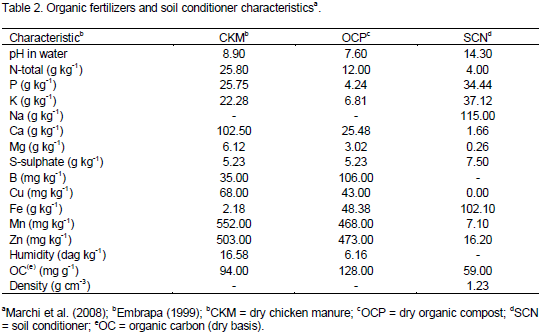
Lettuce growth
Fertilized soil (2.75 kg pot-1) was incubated for ten days before lettuce planting. Lettuce (iceberg, cv. Raider) was planted 35 days after germination, when plants presented four leaves. Plants were harvested 57 days after planting. After harvesting, lettuce height, circumference, total number of leaves, fresh and dry shoot weight, and fresh and dry shoot commercial (lettuce excluding external leaves) weight were measured. Lettuce leaves were dried in oven at 60°C for 48 h, digested in nitro-percloric acid, and analyzed for N, P, K, Ca, Mg, S, B, Cu, Fe, Mn, and Zn content by atomic absorption spectrometry or flame photometry (EMBRAPA, 1999).
Experimental design and statistics
The experiment was completely randomized in a factorial scheme 5x3x2. In the first level, 3 types of fertilizers (CKM, OCP and mineral), in limed and unlimed soil were studied and, in the second level, five doses of soil conditioner (0, 20, 40, 100 and 200 L ha-1), with five replicates. The analysis of variance was performed to test lettuce production as function of tested factors (soil conditioner, fertilizers and liming). Scott Knott test, at 5% of probability was performed.
The analysis of variance showed that lettuce height data were affected significantly with SCN, fertilizers and liming. Other lettuce characteristics, such as number of leaves, circumference, shoot fresh weight, and shoot commercial dry weight data were affected significantly only with fertilizers and liming. Data of shoot dry weight and shoot commercial fresh weight were affected significantly only with fertilizers.
When lime was not used, lettuce produced with mineral and CKM fertilizers was higher than lettuce produced with OCP. When lime was applied, lettuce height followed the order: mineral fertilization > CKM > OCP (Table 3). Mantovani et al. (2005) showed that high amounts of compost may decrease lettuce production due to nutrients in excess. A possible cause for the small lettuce height when produced with OCP may be excess of boron in this fertilizer. Average concentration of B in lettuce leaves produced with OCP was 212 and 160 mg kg-1 in limed and unlimed soil, respectively (Table 4). An increase of B adsorption is observed after raising the soil pH (Soares et al., 2008). Therefore, with the addition of lime, B was less available to plant uptake. Symptoms of B toxicity in lettuce produced with OCP, such as those described by Choi et al. (2006) were noticed. Adequate values for B in lettuce leaves were reported to be 30 to 60 mg kg-1 (van Raij et al., 1997). Except for B, the content of other nutrients in leaves of plants produced with all studied fertilizers were in adequate proportions (van Raij et al., 1997).
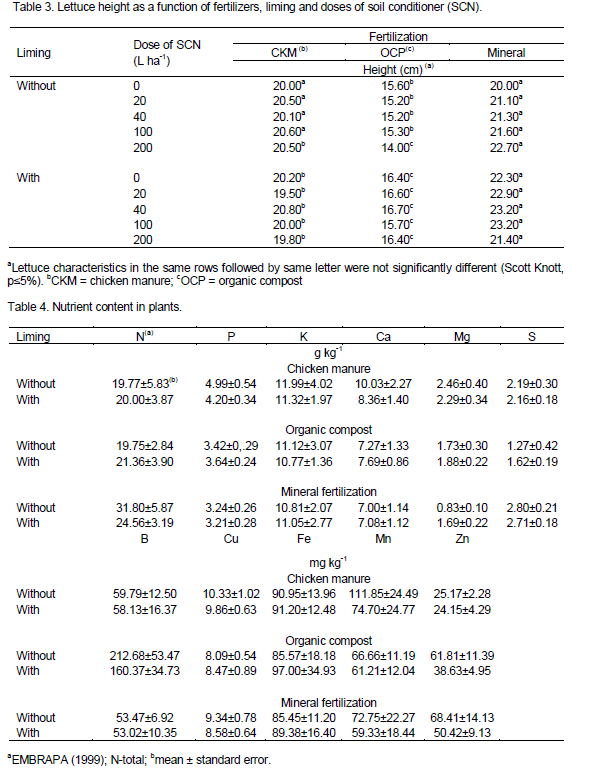
In unlimed soil, increases in pH were noticed after CKM and OCP were applied (Table 5). Increases in pH were probably the main responsible for, except by lettuce height, overall better lettuce characteristics with CKM than with mineral fertilizers. Organic fertilizers naturally increased soil pH, and worked as a pH buffer, preventing pH changes in soil. However, when liming was applied, lettuce produced with mineral fertilizers was taller than that produced with organic fertilizers. Even though mineral fertilization caused soil pH to be lower than organic fertilization (Table 5), Knight and Mitchell (1983) found that optimum lettuce growth occurred at pH 5.9. The pH was, therefore, better adjusted for the recommended lettuce production with use of mineral fertilizers than with organic fertilizers.
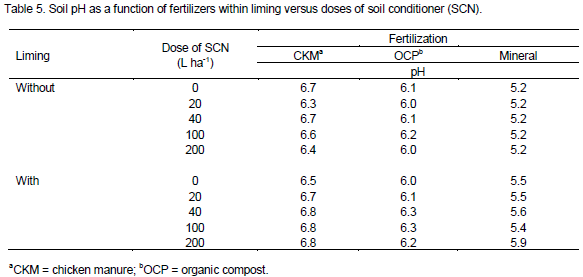
Liming did not influence significantly lettuce height with organic fertilizers, except with OCP at 200 L SCN ha-1 (Table 6). Soil conditioner, at 200 L ha-1 may have enhanced boron toxicity, decreasing lettuce height when produced with OCP. In the unlimed soil, lettuce produced with mineral fertilizers was higher with increases in SCN doses according to the equation:
y = 20.53 + 0.0112x (R2 = 0.86; P<0.05).
Where y= lettuce height, and X = amount of SCN applied
Although the amount of organic carbon added to the soil by SCN was small, it may show its role as soil conditioner, improving conditions for plant growing due to its chemical characteristics (Table 2). Lettuce quality and yield was reported to increase with use of SCN even in small quantities (Valšíková and Viteková, 2006).
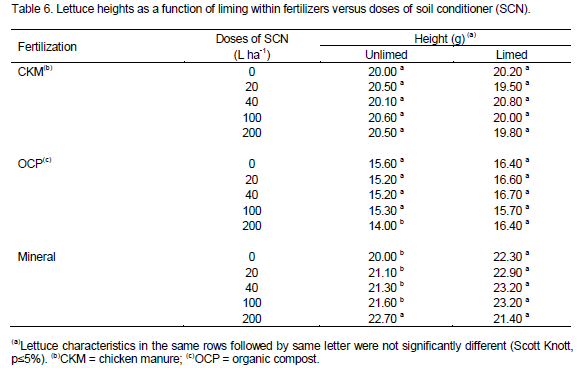
Circumference and shoot fresh commercial weight are the most important lettuce characteristics affecting consumer purchase decisions (Mota et al., 2001). Lettuce number of leaves, circumference, shoot fresh weight, and shoot commercial dry weight were higher when produced with CKM than with OCP or mineral fertilizers (Table 7). Content of P, Ca, and Mg in leaves were higher in lettuce produced with CKM than with other used fertilizers, and it may have accounted to increase lettuce growth (Table 4). These characteristics did not change with liming, when lettuce was produced with CKM, except the number of leaves, which were increased in unlimed soil. When lettuce was produced with OCP, liming increased all of these characteristics, except circumference, which was not affected statistically by the treatments. When lettuce was produced with mineral fertilizers, only shoot fresh weight increased with liming, the other characteristics remained the same statistically. Differences between lettuce characteristics, in general, despite the use of lime, were very small within fertilizers (Table 7).
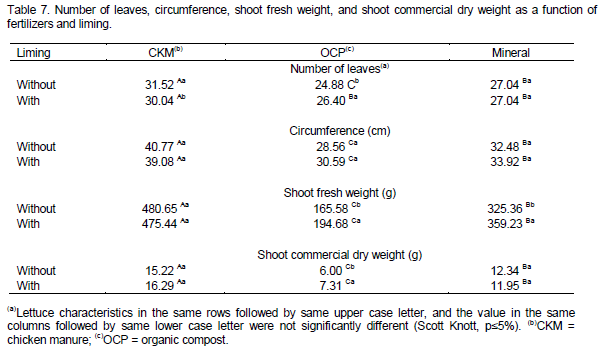
Ali et al. (2007) reported that lettuce weight may be lower when there is low N availability, however, in the present experiment, N amount was, theorically, leveled to all treatments. Then, organic matter mineralization is the only way N availability could influence lettuce growth. Shoot dry weight of lettuce was the same when produced with CKM and mineral fertilizers (Table 8). However, shoot commercial fresh weight, important lettuce characteristic which attract consumers, was higher when produced with CKM than with mineral fertilizers. This difference, between dry and fresh weight for lettuce is the water content. Malathi et al. (2005) showed that in cowpea plants with increased levels of calcium in tissue, the water status was higher than in plants with low levels of Ca in tissue, while the rate of water loss after harvesting was lower in plants with higher levels of Ca in tissue. Calcium content in lettuce produced with CKM was higher than with mineral fertilizers (Table 7). Adequate values for Ca in lettuce leaves are from 15 to 25 g kg-1 (van Raij et al., 1997). These levels are above those found in the present work for lettuce grown with all kinds of fertilizers. For lettuce produced with OCP, the weight for both characteristics was smaller than that produced with CKM and mineral fertilizers.

(1) Lettuce growth characteristics were modified according to the soil management. When lime was applied, treatments with mineral fertilization produced higher lettuce plants than those produced with organic fertilizers. Lettuce height was also affected by the highest dose of SCN in unlimed soil.
(2) Lettuce number of leaves, circumference, shoot fresh weight, and shoot commercial fresh and dry weight, which are important characteristics for consumers, were higher when produced with CKM than with OCP or mineral fertilizers. Probably the increase in these characteristics were reflex of a rise in soil pH and in the higher amount of P added initially with the CKM than with the other treatments. Higher soil pH and P content probably led to an increase in the P, Ca, and Mg content in leaves of lettuce produced with CKM.
The authors have not declared any conflict of interest.
REFERENCES
Ali M, Griffiths AJ, Williams KP (2007). Jones, D.L. Evaluating the growth characteristics of lettuce in vermicompost and green waste compost. Eur. J. Soil Biol. 43:316-319.
Crossref |
|
|
Choi E, Mcneill A, Coventry D, Stangoulis J (2006). Whole plant response of crop and weed species to high subsoil boron. Austr. J. Agric. Res. Skatole, 57:761-770.
Crossref |
|
|
|
CFSEMG-Comissão de Fertilidade do Solo Do Estado De Minas Gerais, (1999). Recomendações para o uso de corretivos e fertilizantes em Minas Gerais, 5° aproximação. Viçosa: UFV. P 359. |
|
|
|
Costa CA, Casali VWD, Loures EG Cecon PR, Jordão CP (1994). Teor de metais pesados em alface (Lactuca sativa L.) adubada com composto orgânico de lixo urbano. Rev. Ceres 41:629-640. |
|
|
|
EMBRAPA-Empresa Brasileira de Pesquisa Agropecuária. (1999). In: Manual de análises químicas de solos. Rio de Janeiro: Centro Nacional de Pesquisas de Solos. P 370. |
|
|
|
EMBRAPA-Empresa Brasileira de Pesquisa Agropecuária. (2009). In: Sistema brasileiro de classificação de solos. 2. ed., Rio de Janeiro: Centro Nacional de Pesquisas de Solos. P 412. |
|
|
|
García AC, Izquierdo FG, Berbara RLL (2014). Effects of humic materials on plant metabolism and agricultural productivity. In: Ahmad P (ed.), Emerging technologies and management of crop stress tolerance. 1st. ed. New York: Elsevier. 1:449-466. |
|
|
|
Knight SL, Mitchell CA (1983). Enhancement of lettuce yield by manipulation of light and nitrogen. J. Am. Soc. Hortic. Sci. 108:750-754. |
|
|
Lulakis MD, Petsas SI (1995). Effect of humic substances from vine-canes mature compost on tomato seedling growth. Bioresour. Technol. 54:179-192.
Crossref |
|
|
Luz JMQ, Oliveira G, Queiroz AA, Carreon R (2010). Aplicação foliar de fertilizantes organominerais em cultura de alface. Hortic. Brasil. 28:373-377.
Crossref |
|
|
|
Malathi C, Gupta K, Prasad TG, Sastry KSK, Kumar MU (2005). En-hancement of water status by calcium pretreatment in groundnut and cowpea plants subjected to moisture stress. Plant Soil 91:109-114. |
|
|
|
Mantovani Jr, Ferreira ME, Cruz MCP (2005). Produção da alface e acúmulo de nitrato em função da adubação nitrogenada. Hortic. Brasil. 23:758-762. |
|
|
Marchi ECS, Alvarenga MAR, Marchi G, Silva CA, Souza Filho, JL (2008). Efeito da adubação orgânica sobre as frações de carbono de solos cultivados com alface Americana. Ciên. Agrotecnol. 32:1760-1766.
Crossref |
|
|
|
Mota JH, Souza RJ, Silva EC, Carvalho JG, Yuri JE (2001). Efeito do cloreto de potássio via fertirrigação na produção de alface-americana em cultivo protegido. Ciên. Agrotecnol. 25:542-549. |
|
|
|
Novais RF, Neves JEL, Barros NF (1991). Teores de nutrientes a serem adicionados ou atingidos em ensaios de vaso. In: Oliveira AJ, Garrido WE, Araújo JD, Lourenço S (ed.). Métodos de pesquisa em fertilidade do solo. Brasília: Embrapa SEA. pp.195-195. |
|
|
Peixoto Filho JU, Freire MBGS, Freire FJ, Miranda MFA, Pessoa LGM, Kamimura KM (2013). Produtividade de alface com doses de esterco de frango, bovino e ovino em cultivos sucessivos. Rev. Bras. Engenharia Agrícola Ambiental 17:419-424.
Crossref |
|
|
Silva FAM, Villas Bôas RL, Silva RB (2010). Resposta da alface à adubação nitrogenada com diferentes compostos orgânicos em dois ciclos sucessivos. Acta Sci. Agron. 32:131-137.
Crossref |
|
|
|
Silva RM, Jablonski A (1995). Uso de ácidos húmicos e fúlvicos em solução nutritiva na produção de alface. Rev. Escola Engenharia, 3:71-78. |
|
|
|
Silva RM, Jablonski A, Siewerdt L, Silveira Júnior P (1999). Crescimento da parte aérea e do sistema radicular do milho cultivado em solução nutritiva adicionada de substâncias húmicas. Rev. Bras. Agrociên. 5:101-110. |
|
|
Silva RM, Jablonski A, Siewerdt L, Silveira Júnior P (2000). Desenvolvimento das raízes do azevém cultivado em solução nutritiva completa, adicionada de substâncias húmicas, sob condições de casa de vegetação. Rev. Bras. Zootecnia 29:1623-1631.
Crossref |
|
|
|
Soares MR, Casagrande JC, Alleoni LRF (2008). Adsorção de boro em solos ácricos em função da variação do pH. Rev. Bras. Ciên. 32:111-120. |
|
|
|
Soil Survey Staff (1999). Soil Taxonomy: A basic system of soil classification for making and interpreting soil surveys. In: Agriculture Handbook, P. 436. USDA-NRCS, Washington. |
|
|
|
Stevenson FJ (1994). Humus chemistry: genesis, composition, reactions, 2.ed. New York: J. Wiley & Sons. P 512. |
|
|
|
Van Raij B, Cantarella H, Quaggio JA, Furlani AMC (1997). Recomendações de adubação e calagem para o Estado de São Paulo. In: Boletim técnico n.100. 2ed. Campinas: Instituto Agronômico. P 285. |
|
|
|
Valšíková M, Viteková A (2006). The effect of Lignofert organic fertilizer on formation and quality of head lettuce yield. Hort. Sci. 33:114–118. |
|
|
|
Zachariakis M, Tzorakakis E, Kritsotakis I, Siminis CI, manios V (2001). Humic substances stimulate plant growth and nutrient accumulation in grapevine rootstocks. Acta Hort. 549:131-136. |
|
|
